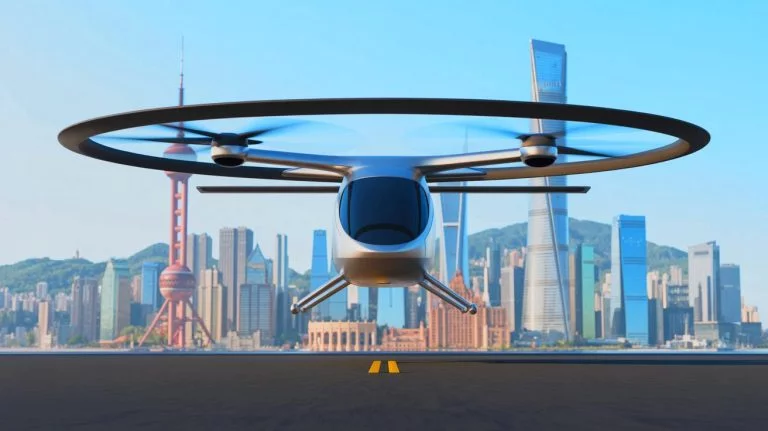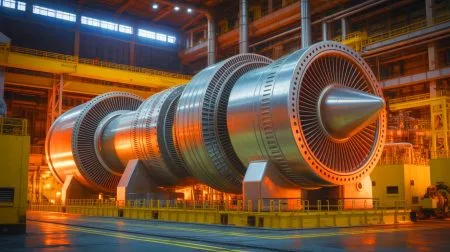| IN A NUTSHELL |
|
In an era where technological advancements continue to reshape industries, the aviation sector is witnessing a revolutionary transformation with the introduction of electric Vertical Takeoff and Landing (eVTOL) aircraft. Leading this charge is AutoFlight, a Shanghai-based tech company, which has delivered the world’s first electric vertical takeoff and landing aircraft over one ton to receive all three major airworthiness certifications. This groundbreaking achievement marks a significant milestone in the development and certification of large-scale eVTOL aircraft and sets the stage for the commercial rollout of low-altitude flight services.
World’s First Certified Two-Ton eVTOL Aircraft
The CarryAll V2000CG, developed entirely by AutoFlight, stands as a testament to innovation in the aviation industry. This unmanned, fully electric aircraft boasts a maximum takeoff weight of approximately 4,400 pounds (two metric tons), making it a formidable player in its field. With a payload capacity of 880 pounds (400 kilograms), a cruising speed of about 124 mph (200 kph), and a maximum range of 124 miles (200 km), the CarryAll V2000CG combines the vertical lift capability of a helicopter with the efficient cruising of a fixed-wing aircraft.
AutoFlight envisions the aircraft serving a variety of purposes, including cargo delivery, emergency supply transport, and disaster response missions. The vertical takeoff and landing ability of the eVTOL enables it to operate efficiently in tight spaces, while its electric propulsion system ensures quieter and cleaner operations compared to traditional aircraft. This achievement aligns with China’s national effort to accelerate its “low-altitude economy,” aiming to develop and commercialize air mobility services for various sectors.
China’s Growth in the eVTOL Market
China is positioning itself at the forefront of the eVTOL market, with numerous cities exploring innovative applications for these aircraft. In the northeast, Shenyang has completed test flights for low-altitude sightseeing, tapping into the potential of aerial tourism. According to AutoFlight, this breakthrough in technology and certification pushes large eVTOL aircraft from concept to reality, marking a major step toward commercial use in real-world logistics and emergency operations.
The global eVTOL market is experiencing rapid growth, with companies making significant strides in securing major orders. For instance, Chinese firm TCab Tech recently signed a $1 billion agreement with UAE-based Autocraft to purchase 350 E20 eVTOL aircraft. Such deals reflect the increasing international interest in Chinese-built eVTOL platforms, underscoring the importance of this technology for the future of logistics and transportation, especially in urban and remote areas.
Key Specifications of the CarryAll V2000CG
| Feature | Specification |
|---|---|
| Maximum Takeoff Weight | 4,400 pounds (2,000 kg) |
| Payload Capacity | 880 pounds (400 kg) |
| Cruising Speed | 124 mph (200 kph) |
| Maximum Range | 124 miles (200 km) |
The Future of Urban Air Mobility
With the successful certification and delivery of the CarryAll V2000CG, AutoFlight is poised to become a leader in the global effort to commercialize new electric aircraft. The expansion of China’s low-altitude economy suggests that these platforms will play a crucial role in shaping the future of urban air mobility. As cities continue to develop drone logistics routes and explore various use cases, the potential for eVTOL aircraft to revolutionize transportation and logistics becomes increasingly apparent.
As the world embraces this technological advancement, the question remains: How will the integration of eVTOL aircraft transform the way we perceive and utilize airspace in urban environments?
Did you like it? 4.4/5 (25)








Wow, a 2-ton eVTOL! 🚁 Is this the beginning of flying cars?
How safe is this new eVTOL technology compared to traditional helicopters?
China’s definitely stepping up its game in the aviation world. Impressive!
Will we see this eVTOL technology in other countries soon?
Sounds like the Jetsons are becoming reality! 😂
Why is it being called the “death of the helicopter era”? Aren’t helicopters still useful?
Thanks for the article! Exciting times for aviation enthusiasts. ✈️
This is a game-changer. Can’t wait to see how it performs in real-world conditions.
How does this eVTOL handle adverse weather conditions?
The payload capacity seems a bit low. Is it suitable for commercial use?
Electric propulsion means quieter flights. That’s a huge plus for urban areas!
Hope this doesn’t lead to more air traffic congestion. 😅
Is it fully autonomous, or does it require a pilot?
China’s eVTOL market is booming! What’s next, eVTOL taxis?
Could this technology be adapted for personal use?
Why is the range only 124 miles? Can it be improved?
I’m skeptical. Helicopters have been around for ages for a reason!
Where can I book a flight on one of these? 😄
I’m curious about the environmental impact of producing these eVTOLs.
Thank you for sharing this article. Very informative! 🙌
Will we ever see eVTOL races? That would be thrilling! 🚀
How does this affect the job market for helicopter pilots?
Is this the start of a new aviation arms race between countries?
The future is here! Can’t wait to see what’s next.
Does anyone know if this competes with existing drones?
Would love to see these flying over my city! 🌆
Is the technology scalable for larger payloads?
The range might limit its use for longer hauls. Any plans to extend it?
How much does one of these eVTOLs cost? 💰
Hope they’re not too noisy over residential areas.
Looks like sci-fi tech is becoming reality. Amazing!
How does this compare to Tesla’s rumored flying car projects?
Will this technology help in reducing carbon footprints?
Interesting read! How many of these are in operation currently?
Can it land on water or rough terrain?
What are the plans for integrating this tech into existing air traffic systems?
Is there a backup system in case of power failure? 🤔
Great to see innovation in aviation. What’s next on the horizon?
Are there any safety concerns with eVTOLs that need addressing?
Can’t believe we’re living in the future. Exciting times ahead!